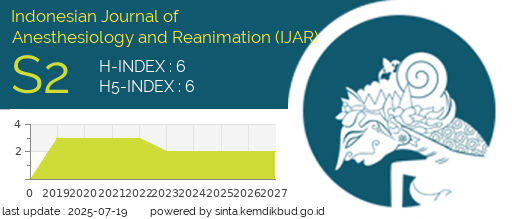Acute Respiratory Distress Syndrome (ARDS) Management Severe COVID-19
Downloads
Introduction: The Coronavirus disease 2019 (COVID-19) caused a global pandemic and many management challenges. Acute Respiratory Distress Syndrome (ARDS) is one of the most common pneumonia complications in COVID-19 cases. ARDS in COVID-19 have worse outcomes and increased risk of intensive care unit (ICU) admission. Objective: This case report aims to recognize and understand ARDS management in a severe COVID-19 case. Case Report: A 68-year-old man with diabetes mellitus and hypertension arrived at the Emergency Room (ER) after experiencing five days of fever, cough, diarrhea with frequency of four times a day, weakness, and a positive antigen result for COVID-19 at admission. Anosmia was absent. The patient had been vaccinated for COVID-19 twice. The main problem was his desaturation of 88%, blood pressure of 156/73 mmHg, heart rate of 80x/minute, and respiratory rate of 20x/minute. However, the patient was alert and admitted to the isolation ward. After 21 days of hospitalization, the patient's condition worsened. The patient developed ARDS and was referred to the COVID ICU for 25 days and 20 days to the non-COVID ICU, where he was intubated, and a tracheostomy was performed. After 45 days of admission to the ICU, the patient's condition improved. Discussion: COVID-19 patients with ARDS should be immediately intubated when conditions such as dyspnea, RR>30x/min, SpO2<92% (for patients with no comorbidities) or <95% (for patients with comorbidities), unconsciousness, or shock appears. Furthermore, other conditions, such as an HR> of 120x/min and a ROX index of <3.851, should be considered an indication for intubation. Conclusion: Timely intubation improves the outcome of COVID-19 patients with ARDS.
Rehman SU, Rehman SU, Yoo HH. COVID-19 challenges and its therapeutics. Vol. 142, Biomedicine and Pharmacotherapy. Elsevier Masson s.r.l.; 2021.
Burhan E, Dwi Susanto A, Isbaniah F, Aman Nasution S, Ginanjar E, Wicaksono Pitoyo C, et al. PEDOMAN TATALAKSANA COVID-19 Edisi 3 TIM EDITOR Perhimpunan Dokter Paru Indonesia (PDPI) Perhimpunan Dokter Spesialis Kardiovaskular Indonesia (PERKI) Perhimpunan Dokter Spesialis Penyakit Dalam Indonesia (PAPDI) Perhimpunan Dokter Anestesiologi dan Terapi Intensif Indonesia (PERDATIN) Ikatan Dokter Anak Indonesia (IDAI). 2020.
Jiang F, Deng L, Zhang L, Cai Y, Cheung CW, Xia Z. Review of the Clinical Characteristics of Coronavirus Disease 2019 (COVID-19). Vol. 35, Journal of General Internal Medicine. Springer; 2020. p. 1545–9.
Stone JH, Frigault MJ, Serling-Boyd NJ, Fernandes AD, Harvey L, Foulkes AS, et al. Efficacy of Tocilizumab in Patients Hospitalized with Covid-19. New England Journal of Medicine. 2020 Dec 10;383(24):2333–44.
Salama C, Han J, Yau L, Reiss WG, Kramer B, Neidhart JD, et al. Tocilizumab in Patients Hospitalized with Covid-19 Pneumonia. New England Journal of Medicine. 2021 Jan 7;384(1):20–30.
Rizvi S, Kreuwel H. Intravenous Immunoglobulin for Treatment of Severe Coronavirus Disease 19 (COVID-19) – A Literature Overview. Journal of Allergy and Clinical Immunology. 2021 Feb;147(2):AB67.
Pisano A, Yavorovskiy A, Verniero L, Landoni G. Indications for Tracheal Intubation in Patients With Coronavirus Disease 2019 (COVID-19). Vol. 35, Journal of Cardiothoracic and Vascular Anesthesia. W.B. Saunders; 2021. p. 1276–80.
Turan S, Sevim Yakin S, Yamanel L. The timing of intubation and principles of ICU care in COVID-19. Turk J Med Sci. 2021;51:3340–9.
Hur K, Price CPE, Gray EL, Gulati RK, Maksimoski M, Racette SD, et al. Factors Associated With Intubation and Prolonged Intubation in Hospitalized Patients With COVID-19. Otolaryngology-Head and Neck Surgery (United States). 2020 Jul 1;163(1):170–8.
Yamamoto R, Kaito D, Homma K, Endo A, Tagami T, Suzuki M, et al. Early intubation and decreased in-hospital mortality in patients with coronavirus disease 2019. Crit Care. 2022 Dec 1;26(1).
Copyright (c) 2023 Helen Yudi Irianto, Akhmad Yun Jufan

This work is licensed under a Creative Commons Attribution-ShareAlike 4.0 International License.
Indonesian Journal of Anesthesiology and Reanimation (IJAR) licensed under a Creative Commons Attribution-ShareAlike 4.0 International License.
1. Copyright holder is the author.
2. The journal allows the author to share (copy and redistribute) and adapt (remix, transform, and build) upon the works under license without restrictions.
3. The journal allows the author to retain publishing rights without restrictions.
4. The changed works must be available under the same, similar, or compatible license as the original.
5. The journal is not responsible for copyright violations against the requirement as mentioned above.


















